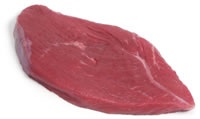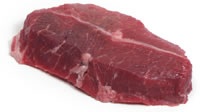Special Feature: Products Sally Recommends
FOUR FOR THE MONEY: Full Flavored Steaks For Less
 Even before our wallets flattened, the beef industry had been working to swell the steak portfolio for consumers by designing new cuts for the grill that were once consigned to the roasting pan. Today we don’t have to pay top prices for the traditional top tender cuts like rib-eye or club steak, Porterhouse or T-bone to get the pleasure of flavor-packed beef, crusty outside and tender within. While flank and skirt steaks have long been favorite cheaper cuts that can be tenderized by marination and then grilled, we now have four really good cuts to add to those. Usually they are less expensive per pound than either flank or skirt.
Even before our wallets flattened, the beef industry had been working to swell the steak portfolio for consumers by designing new cuts for the grill that were once consigned to the roasting pan. Today we don’t have to pay top prices for the traditional top tender cuts like rib-eye or club steak, Porterhouse or T-bone to get the pleasure of flavor-packed beef, crusty outside and tender within. While flank and skirt steaks have long been favorite cheaper cuts that can be tenderized by marination and then grilled, we now have four really good cuts to add to those. Usually they are less expensive per pound than either flank or skirt.
Their one disadvantage is that often they come packaged with names you’ve never heard of , which seem to be confusingly interchangeable with other names you’ve never heard of. A cut from the muscle that is called the top blade is now being labeled Flatiron Steak, for example, which is interchangeable with Lifter Steak, Triangle Steak, Book Steak. Oh shucks, you name it. Visually, it has a triangular shape (like a flatiron, but you know it wasn’t a woman who picked that name) and a connective tissue that runs down the middle of it.
 A sirloin or round tip sounds familiar enough but it’s cut from what we used to find only as a round (or rump) roast. Because it is next to the sirloin, this steak is apt to be tenderer than other parts of the round. Chuck certainly sounds familiar as hamburger or a pot roast, but a chuck steak? It turns out that a thin slice cut from the shoulder has got all the flavor of the chuck primal and just needs marination to make it tender enough for grilling. The same is true of what the meat counter is serving up as Tri-tip Steak. It’s a long skinny one cut from the juncture of sirloin, round and flank and has enough fat to make it a tender delight without marination. Confusingly it’s sometimes called Culotte Steak.
A sirloin or round tip sounds familiar enough but it’s cut from what we used to find only as a round (or rump) roast. Because it is next to the sirloin, this steak is apt to be tenderer than other parts of the round. Chuck certainly sounds familiar as hamburger or a pot roast, but a chuck steak? It turns out that a thin slice cut from the shoulder has got all the flavor of the chuck primal and just needs marination to make it tender enough for grilling. The same is true of what the meat counter is serving up as Tri-tip Steak. It’s a long skinny one cut from the juncture of sirloin, round and flank and has enough fat to make it a tender delight without marination. Confusingly it’s sometimes called Culotte Steak.
Despite their names, all of these are worth your time and money. Some will be thicker and some will be thinner. Some will be tougher, some tenderer. I find myself nowadays looking first through the Cryovac seal for the price per pound and if it’s $4.98 or less, I figure I’m ahead of the game because I’m paying probably less than half the price of the top steak cuts. Besides, I like to fool around with marinades, try different flavor combinations, knowing that whatever I paint on the surface there’s going to be that great beefy canvas underneath.
 This is a Mexican-based marinade I use a lot for flank and skirt steaks as well as any of the cuts above, for the simple reason that everything in it works together---the sweet tartness of orange and lime, the pungency of onion and garlic, the earthiness of cumin, the herbal intensity of oregano, all bound together in tenderizing harmony with olive oil. And the only things you have to do to your steak other than grill it is marinate it before and eat it afterwards.
This is a Mexican-based marinade I use a lot for flank and skirt steaks as well as any of the cuts above, for the simple reason that everything in it works together---the sweet tartness of orange and lime, the pungency of onion and garlic, the earthiness of cumin, the herbal intensity of oregano, all bound together in tenderizing harmony with olive oil. And the only things you have to do to your steak other than grill it is marinate it before and eat it afterwards.
![]()
Citrus Chili Marinade
For 2 to 3 pounds steak (any of the cuts above)
1 small onion, chopped coarsely
3 cloves garlic, chopped coarsely
2 tablespoons fresh orange juice
3 tablespoons fresh lime juice
3 tablespoons olive oil
1 ½ teaspoons cumin, ground
1 ½ teaspoons chipotle chili, ground
1 ½ teaspoons Mexican oregano
1 ½ tablespoons black pepper
1 teaspoon sea salt
Put all the ingredients but the meat into a blender and puree. Put the meat in a large plastic bag and pour the marinade over it. Close the bag and massage the marinade into the meat. Refrigerate for at least 3 hours or overnight. Length of grilling time depends mostly on the thickness of the steak but partly on the cut. Tri-tip should be cooked quickly to avoid toughening by overcooking. Boneless Chuck and Sirloin Tip should be cooked quickly because they are usually cut thin. Flatiron is a thicker cut and because it is well marbled will behave more like a rib-eye, so test its interior by making a small cut with a sharp knife while it cooks. With thin steaks, it’s important to sear them on both sides over the highest heat you can get, then take them off the fire and let them rest 5 to 10 minutes because they will continue to cook inside. The rest period is essential to all steaks to let the juices contract back into the flesh, but is especially true of thin ones that can overcook in a second. Remember that the citrus in the marinade chemically “cooks” the flesh slightly in the way a seviche does, so that marinades of this type will tend to lessen the cooking times you’re used to with the top cuts. But that marinade will help even an overcooked steak to taste good.
![]()
Betty Fussell is a food historian, home cook, author, English professor and freelance writer. Her book, The Story of Corn, was reprinted by University of New Mexico Press. Fussells' memoir My Kitchen Wars, was transformed into a one-woman show performed in New York City and Hollywood. Fussell latest book is a history of American beefsteak titled Raising Steaks: The Life and Times of American Beef.
Note: This information was accurate when it was published. Please be sure to confirm all rates and details directly with the businesses in question before making your plans.



